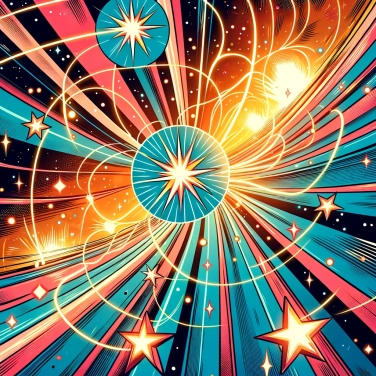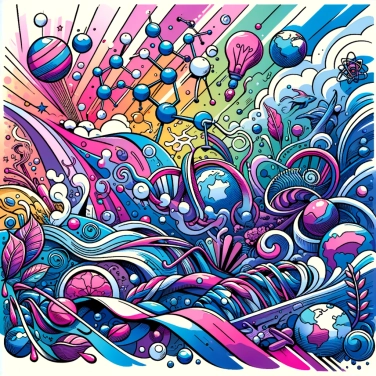Some stars, such as neutron stars or magnetars, have extremely powerful magnetic fields due to their density and rapid rotation, which amplify the star's initial magnetic field.

When a star spins hyper-fast on itself, the plasma it contains swirls intensely, somewhat like water in a washing machine on high spin. This movement creates what is called a dynamo effect: the rapidly rotating charged particles generate a powerful magnetic field. The faster the rotation, the more this dynamo effect is amplified, producing extremely strong magnetic fields. Some young stars, or those that contract quickly, sometimes spin at crazy speeds, which is why their magnetic fields are particularly intense.
In the stars, convection resembles the perpetual motion of a hot soup that is constantly stirred: the hot material rises to the surface, cools down, and then sinks back into the depths. These internal movements churn electrically charged plasma, thereby creating a dynamo effect that significantly amplifies the magnetic fields. Some stars have a deep and turbulent convective zone, which generates powerful turbulent flows capable of further enhancing these fields. The more turbulent and dynamic these internal exchanges are, the more the magnetic field can reach extreme intensities.
Stars are primarily composed of plasma, a superheated and ionized gas that contains free electrical charges (electrons and ions). This plasma is constantly in motion, and these movements of charged particles generate and sustain electric currents. And where there are electric currents, there are necessarily magnetic fields. This mechanism, called the dynamo effect, then amplifies the star's initial magnetic field. Once powerful, this field itself influences the trajectory of the plasma, creating complex loops, arcs, and magnetic knots that make stars particularly active and energetic. When we observe violent solar eruptions or dark spots on the surface of a star, it is precisely because the plasma trapped in these magnetic loops is in full agitation. The faster the star spins and the more its interior boils, the stronger the interaction between plasma and magnetic field becomes, and the more extreme the generated fields become.
The chemical composition greatly influences the magnetic fields of stars. Some stars contain large amounts of specific elements like iron or neodymium, often referred to as "heavy elements." Why do these elements matter so much? Because they create a different nature in their atmosphere. These heavy, electrically charged atoms actively participate in the internal movements of plasma, amplifying the magnetic effects generated by convection. In short, these stars rich in heavy elements essentially act as powerful conductors, facilitating the formation and strengthening of extremely intense magnetic fields.
When a star orbits very close to another star, their gravitational and magnetic interactions can significantly boost its magnetic field. This proximity generates tidal forces that modify the inside of the star, intensifying internal currents and energizing the generation of the magnetic field. Additionally, the direct exchange between the two celestial bodies, often accompanied by mass transfer, frequently injects ionized gas (plasma) into one star. This additional plasma amplifies and disrupts the existing magnetic field, thereby creating a powerful dynamo effect. Some binary systems, particularly close binaries, thus become natural laboratories where magnetic fields literally explode in strength.
The strongest magnetic intensity ever observed around a star belongs to certain magnetars. Their magnetic field is so strong that it would distort the very atoms nearby, profoundly altering the very structure of matter itself.
The Sun reverses the polarity of its magnetic field approximately every 11 years. This phenomenon is part of its activity cycle, associated with the appearance of numerous sunspots.
Some stars, known as 'magnetars', have a magnetic field so powerful that it can be billions of times stronger than that of Earth, even capable of disrupting the operation of our satellites from a distance.
The very intense magnetic field of a star significantly influences how light escapes its surface, sometimes causing spectacular effects such as clearly identifiable beams of radio emissions from Earth.
The magnetic field of a distant star is generally detected through the Zeeman effect, which is the characteristic splitting of spectral lines in the presence of a strong magnetic field. Modern telescopes and spectroscopes can accurately identify this phenomenon, thereby revealing the presence and intensity of a star's magnetic field.
Yes, stellar magnetic fields can evolve significantly over the life of a star. Internal processes such as convection, rotation, and variations in magnetic activity lead to an increase or decrease in the strength of the magnetic field.
Pulsars and magnetars are neutron stars, extremely compact objects resulting from the collapse of the core of a massive star. Their extreme density and very rapid rotation create a dynamo effect that significantly amplifies their magnetic field. Magnetars even possess the most powerful magnetic fields known in the observable universe.
Absolutely! Stellar magnetic fields greatly influence their immediate environment, including the potential habitability of nearby planets. A magnetic field that is too strong could expose a planet to high levels of radiation and frequent stellar flares, thereby limiting its ability to support life as we know it.
Yes, almost all stars have a magnetic field, but the intensity varies greatly from one star to another. Some stars, like neutron stars, have extraordinarily strong magnetic fields, while others, such as our Sun, have relatively moderate fields.

No one has answered this quiz yet, be the first!' :-)
Question 1/5